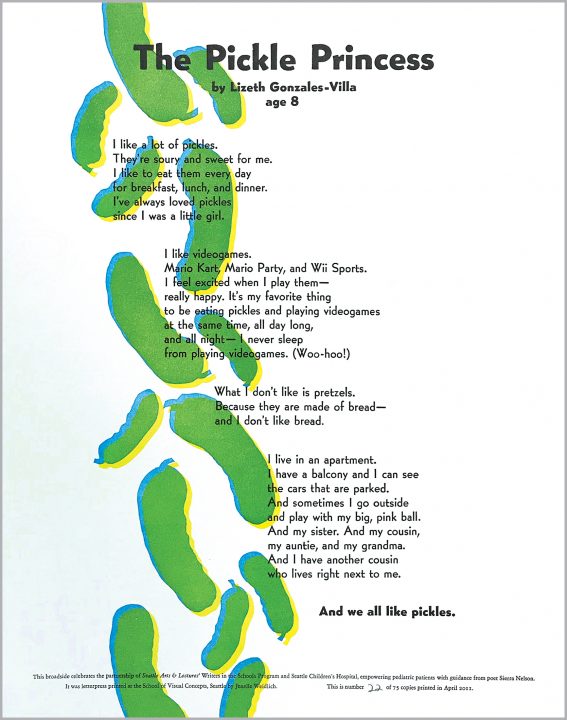
A Decade of Letterpress: Jenelle Weidlich
December 7, 2020
Each year, in a project led by Sierra Nelson and Ann Teplick of Writers in the Schools, and the School of Visual Concepts, long-term patients from Seattle Children’s Hospital and a team of letterpress artists join forces to create an extraordinary collection of handprinted, limited-edition broadsides. In 2020, the Letterpress Program at the School of Visual Concepts became a new organization, Partners in Print, in order to maintain meaningful community collaborations like this one.
These works of art—which you may have oohed and aahed over at the SAL info table at in-person events or seen at local libraries or galleries as they toured around Seattle—are always colorful, fantastical, and deeply felt.
To celebrate a decade of this letterpress project, we’ve asked artists behind the press to give us an inside look at the process of turning youth poetry into art in a series of retrospectives on some of their favorite pieces over the years. Below, Jenelle Weidlich talks us through that process, focusing on “Pickle Princess,” a 2011 broadside created using a poem by Lizeth Gonzales-Villa (then age 8).
How many years have you participated in the project?
I was part of the project for the first four years (2011 – 2015).
What drew you to the poem you worked with?
Lizeth’s poem inspired me immediately because of her playfulness in sharing with us what she likes: video games, playing with her pink ball, and pickles (emphasis on the pickles). The title alone conjures so much fun imagery and I was excited to see where it could lead.
In practical terms, her poem was a good length to print using hand-set type without having to worry about running out of letters—a consideration in letterpress where traditionally each letter printed is an individual piece of type cast into metal and composed by hand into words and sentences. And again, pickles!
What’s the process like to turn a poem into a broadside?
To get an idea of what imagery and style it might inspire, I read the poem repeatedly, daydream, and sketch out various layout ideas. Sometimes, we can meet our poet in person, and I was fortunate to be able to meet Lizeth briefly at Seattle Children’s Hospital and learn more about her and why the nurses all lovingly called her the Pickle Princess.
It’s a wonderful puzzle then to see what combination of design elements most effectively creates the world of the poem on the page. One of my favorite steps is searching through SVC’s vast letterpress type collection to find something that will best suit the piece. The imagery in this case was then created by carving pickle silhouettes into a piece of linoleum and printing it in multiple passes through the press, adjusting the position for each color.
What’s your favorite part of the project as a whole?
Using my skills as a designer and printer to turn someone else’s carefully written words into a piece of art for them and their loved ones to cherish is a great pleasure. To do so for a young person who may be expressing themselves through poetry for the first time, while facing the challenges of serious illness, is especially profound.
I’m also grateful for the sharing of ideas, techniques, and camaraderie that is inevitable when the lovely folks in this printing community come together to work on a worthy project such as this.
Thank you, Jenelle!